FluentU
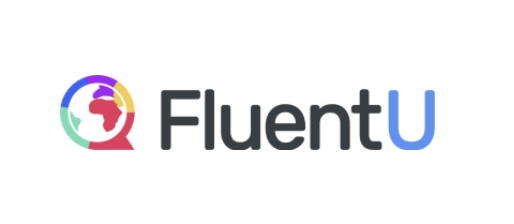
Summary
FluentU is a language-learning platform that uses real-world videos and interactive subtitles to create an immersive learning experience. The videos take on a variety of forms, including commercials, music videos, interviews, and more. Accompanying quizzes give users the chance to practice language used in videos. FluentU offers videos in nine different languages and is available for iOS, Android, and on the web. Most of its content is beyond the beginner level, but it has videos for learners at all levels.
It’s very straightforward and easy to use, though not especially visually pleasing.
There is a wide variety of videos, but they’re short and disconnected. They also aren’t suitable for absolute beginners.
It is not the most complete way to study a language.
I Like
- The site is easy to navigate.
- Interacting with subtitles is easy.
- The videos are authentic and tied to practice activities.
- Exercises recognize Chinese and Japanese characters.
I Don’t Like
- Flashcards use robotic text-to-speech audio.
- Writing practice is limited, speaking practice is nonexistent.
- Practice activities aren’t very interesting.
- There’s no easy way to filter content by region.
Price
After a 14-day free trial, users can purchase one of two subscription options. Subscriptions grant access to all FluentU languages.
Monthly Subscription: $30/month
Annual Subscription: $360/year
Table of Contents
People love videos. We’ve been hooked on them ever since televisions started appearing in living rooms more than half a century ago. You may be more likely to get your fix from a computer or phone these days, but the appeal remains.
The resource in this review uses authentic videos in other languages to turn one of the most engaging types of media into a language-learning tool.
What is FluentU?

FluentU is a language-learning resource with a library of short, authentic videos and accompanying practice exercises. Its teaching methodology is centered around the idea that exposure and interaction with native content is the best way to learn a language.
The videos all make use of interactive subtitles to ensure understanding and allow users to save material for later review to make the experience more enjoyable.
There are videos available in nine different languages, as well as a version for learning English in three different languages. There is material for learners at all levels, though it probably isn’t the best resource for absolute beginners in any language.
How We Did This Review
For this review, multilingual video-master Catherine and I teamed up to test the resource independently and share our findings.
While this was my first real encounter with the platform, Catherine was already well-versed in FluentU and had been using it off and on for some time.
I tried out the material in Spanish, and Catherine took another look at the Chinese and French content.

Catherine:
I am an American vocalist and educator. I perform for multilingual audiences, mostly in English, Mandarin, and French. My interest in language apps is both personal and for my friends and students looking to supplement their study materials. At the moment I am casually learning Japanese and Russian.

Brian:
I’ve studied Spanish off and on for about 15 years now and feel like I’m in “maintenance mode” with the language. I’m not as fluent as I once was, and I’ll take any exposure I can get to keep my skills up while not living in a Spanish-speaking country. I’m hoping FluentU is a viable way to turn interacting with native material into a more efficient study technique.
Quick Opinions
It turns out that Catherine and I have pretty similar feelings about FluentU, and they’re lukewarm.
We both like the fact that videos use native speakers, contain some interesting content, and are easy to interact with. We agree, though, that what’s on offer doesn’t quite feel worth the price. The practice activities don’t have a lot of variation, and you’ll need to find your own supplementary resources to fill out a study plan.
Catherine noted that it could be worth it for more advanced learners to pay for a month at a time once in a while to get some good language exposure, but not on an ongoing basis.
Here’s how we each rated the resource overall:
Catherine: 3/5 Stars
Brian: 3.17/5 Stars
Combined Final Rating: 3.1/5 Stars
Initial Impressions
Not too busy or overly minimalistic, the FluentU platform feels manageable and practical right away. There’s a way to view your achievements, videos to search through, and not much else.
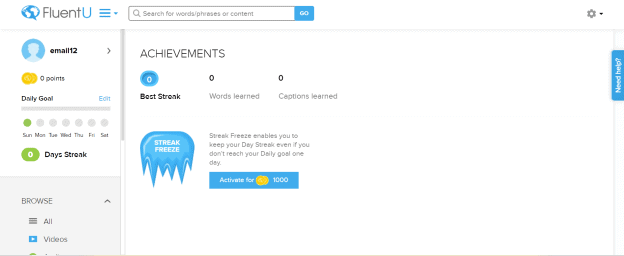
I really appreciate a resource with an interface that doesn’t require a lot of getting used to, but there’s also nothing special about the FluentU aesthetic.
How important is an eye-catching layout? It might matter more to some than others, but I think most would agree that the language-learning potential is the important bit. There’s also something to be said for resources that are straight to the point and don’t distract from their primary use.
In that sense, I’m glad the FluentU made it easy to get practicing right away, though I did have to Google how to change languages (hint: it’s in Settings).
Finding Videos
Fortunately, finding videos on FluentU is pretty easy. There’s a search function, intelligent filters, and easy-to-see video thumbnails. You can search for something you want to learn about, like parts of speech, or by subject, like hospitals or trains.
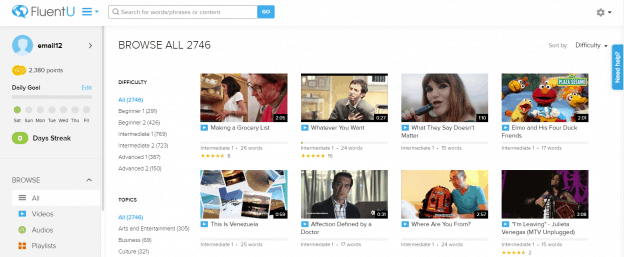
FluentU can understandably proudly boast that it has curated over 1,000 of these videos. Plus, you will consistently find new videos added for each language.
I like how easy it is to see how many videos there are at each level, topic, and format. It’s also super easy to filter the videos by clicking on one of these categories.
As you can see, the majority of the videos in Spanish are for the intermediate level. The topic with the most videos is Everyday Life, and the most popular format is music videos. The distribution is pretty good between the types of videos available; there isn’t one type of video that dominates the library.
Most, if not all, of the videos are less than five minutes long. They won’t lend themselves to any serious binge sessions, but that’s not the point here. Instead, I think the relatively short length is just right for turning the content into small language lessons. Any longer and there would be too much content.
Watching Videos
This is what FluentU is all about! Watching videos on the platform is a pretty smooth experience, and there’s some extra information that makes it easier to turn it into a useful study guide.

Each video comes with a list of vocabulary that it contains. The list provides definitions, a “fluency” meter that shows how comfortable you are with the word, and an audio recording.
Unfortunately, the recordings here aren’t done by native speakers. Instead, they use text-to-speech technology, making for less-natural-more-robotic sounding pronunciations.

You’ll also be able to see a transcript of the entire dialogue, with the ability to listen to a recording of each sentence. Again, you’ll hear a robotic voice hear instead of the voices used in the video itself, which is a shame.
Ok, now to the fun part, what really drives the FluentU experience — videos with interactive subtitles.
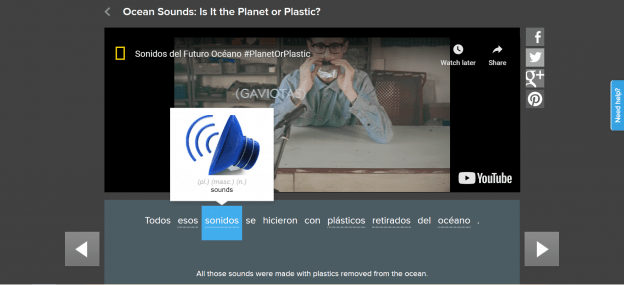
Let’s break down the features that make the subtitles interactive.
Show or Hide
Each video comes with quality subtitles and translations, and you can toggle both of these on and off as you wish. The option to do this is nice, as it can be easy to accidentally rely on the translated subtitles.

It’s also nice to be able to turn off subtitles completely, in case you want to test your listening comprehension on its own.
Hover to Show Translations
Hovering over any word in the subtitles reveals its translation. Hovering over the subtitles also automatically pauses the video, which Catherine and I agree makes for a smoother experience.
The translations do a good job of recognizing context, which is important. If a word is being used as part of a phrasal verb or expression, for example, selecting the word will show the translation of the entire phrase.
You can see what this looks like in the example below.

Clicking on a word or phrase brings up extra information, including example sentences, other video clips that use the language item, and the chance to add it to a flashcard deck for later review.
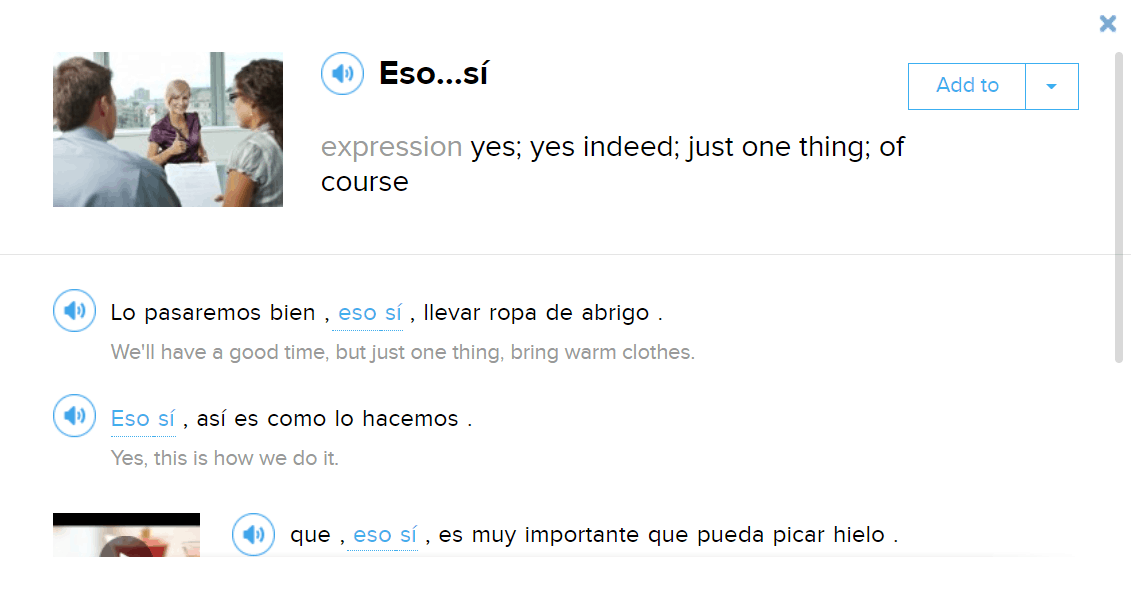
This is a cool feature. The ability to see a new word or phrase in multiple contexts is certainly useful.
Navigate and Repeat Clips
The dialogue in each video is broken up into segments, and navigating between them is fairly simple — there are big arrows on each side of the subtitle box that allow you to easily scroll through clips of dialogue.
There’s also a repeat button that, when enabled, causes the video to loop the current clip over and over. This is handy for tricky bits of dialogue that you might not grasp the first time around. It’s definitely better than manually rewinding the video to hear a small bit repeatedly.
The repeat feature is nice, but it also brings up a feature that’s missing from FluentU and makes it a little less valuable than it could be. There’s no option to slow down playback. For particularly tricky passages of dialogue, slower playback can help in a way that endlessly repeating a clip sometimes can’t.
The lack of a “slow-mo” button isn’t necessarily a dealbreaker, but I found myself missing it. This is something other language-learning resources frequently offer.
Video Practice Exercises
In addition to watching videos, the FluentU platform allows you to partake in various exercises to practice the language in the videos you watch. They’re pretty simple and largely uninteresting, but they’re useful nonetheless.
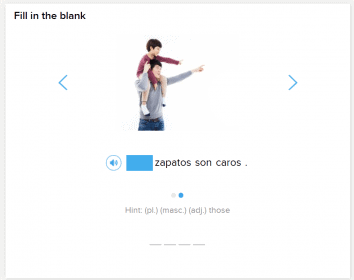
In the above exercise, the user fills in the gap by typing the missing word. For extra help, you can listen to an audio recording of the sentence.
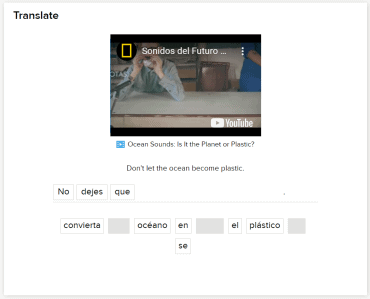
Here, the task is to put the words in the correct order. The sentence comes from the accompanying video and you can watch/listen to the video for help. The English translation is also visible.
There are also some multiple-choice questions that ask you to choose the correct word or translation, but they’re all very similar.
While I really like that these quizzes are available, they’re also pretty repetitive and uninteresting. It wasn’t long before I lost interest in them and wanted to move on to the next video.
I also found myself wishing there were questions to test my comprehension. Especially for intermediate and advanced learners, an opportunity to watch a video with or without subtitles and then test comprehension would be very valuable.
This type of listening happens all the time in real life (where you’re not totally sure what you’re hearing and have to make educated guesses), and a resource that helped learners practice this skill would be a great asset.
Personalized Learning
FluentU recently added a more personalized element to the quiz mode, as well as the ability to set daily video-watching challenges for yourself and track your progress. This could appeal to a goal-oriented person.
In quiz mode, you can now select a “too easy” option if you already know the material, and you won’t get tested on that again. Or, if you have no idea, you can select “don’t know,” and FluentU will help you work on that subject matter in more depth.
Pricing
There are two subscription plans for FluentU: annual and monthly. The annual plan costs $240/year and the monthly plan costs $30/month.

A subscription gives the user access to material for all languages on FluentU.
Tips for How to Use Videos and FluentU to Learn a Language
The biggest benefit of FluentU is that it provides an immersive, close-to-real-life learning environment. After all, not everyone can afford to get on a plane and fly to Spain, China, or Russia! For those stuck learning at home, the challenge is how to fill your day with chances to experience your target language.
Videos, movies, and TV shows often become the next best thing to real life. You get to enjoy the engaging media while also working on listening comprehension, vocabulary, and even pronunciation if you pause to repeat words and phrases.
Whether you go with FluentU videos or pick a different source, check out these tips to get the most out of your viewing experience!
Pause the video frequently
Ok, you may want to watch all the way through once, for fun! But then hit that pause button and carefully repeat, out loud, keywords and phrases from the video. This is the best way to model your pronunciation after native speakers!
It may feel awkward at first to randomly say words out loud to your phone screen or TV. But it gets easier with practice, which will also boost your confidence when you find yourself in a real-life conversation with a native speaker of your target language.
Use the subtitles in several different ways
You may want to watch a video with English subtitles first, for comprehension. Then pause frequently to hover over words you don’t know, and boost your vocabulary.
Finally, try watching the video again, but this time with subtitles in your target language. This can help build your literacy (which is not an element FluentU focuses on a whole lot).
Start a collection of words and phrases, too
You can do this either as a log of vocabulary you have mastered or as a handy way to jot down words you have not yet learned to look up later. You could also use a notes feature on your phone and just toggle back and forth if you’re watching the video clips on your phone anyway!
You could even take this a step further and plug your vocabulary list into a flashcard builder like Anki. This way, you can keep drilling yourself on the new words.
Structure is important
Finally, you should remember that while immersive learning is super important, most language learners will also require a structured program or course to help them learn elements like grammar and literacy.
This means that whether you pick FluentU, YouTube, or even just Netflix for your videos of choice in your target language you will still need to look for a core language program to walk you through the structure of the language.
This is especially true if you plan to learn a language that does not share linguistic roots with English. Languages like Spanish and French do share a lot of history with English, making the shape or structure of French or Spanish easier for an English speaker to recognize.
But a language like Mandarin or Korean does not have a similar structure, so you will need more formal direction to master the sentence structure of those languages.
Alternatives for Complete language courses
FluentU is a supplemental tool, which means that it doesn’t work as a complete course. However, there are some more comprehensive courses out there. Here are some of our picks.
olly (I will teach you a language)

Olly Richards, the creator of I Will Teach You A Language, has written a series of books for beginner and intermediate learners to improve their conversation skills in several languages. He also has a Short Stories series.
Most of the languages use the most common words in your target language, with natural phrases that you would overhear locals using while conversing with each other. In the short story lessons, the plot follows the same characters and adventures, with some adjustments for cultural differences. Here is our review!
Pimsleur

Pimsleur is one of the most popular and longest-standing resources out there for learning a foreign language. Its courses place a strong emphasis on aural and verbal communication skills, paying less attention to grammar explanations and reading or writing skills. There are over 50 language courses available with Pimsleur, and the bulk of the material is taught with audio lessons. Check out our full review here!
Rocket languages

The things that Rocket Languages do well are developing a logical and thorough curriculum and providing ample practice opportunities. Some of the things that this platform has to offer are reading, writing, and listening practice. With Rocket Languages, you also get native-speaker audio that will give you a bunch of exposure to the language. This is just one thing that makes it so unique!
Alternatives For video learning
There are a handful of very similar options when it comes to language learning through videos, and Catherine and I tried out several of them to see how they stack up against each other.
FluentU turned out to be the most expensive option and not necessarily the best. Read on to see what we thought of the others, and check out Catherine’s video to get a more detailed look at what’s available.
Yabla
This is probably the most similar resource to FluentU, and it’s half the price. It’s got some other major advantages as well — the practice activities are more interesting and varied, there are more videos, and the platform is slightly more enjoyable to use.
Unfortunately, there are fewer languages on offer here; there’s no Japanese, Korean, or Russian. You’ll also only get access to one language per subscription. Here’s our Yabla review. Also read our Yabla vs. FluentU review.
3ears
Learners of Russian, Ukrainian, Czech, Polish, Hungarian, and Romanian – you’ll want to check this one out. While there are some videos that ask for payment (less than $2), the vast majority of the content is totally free to use and interact with. There are all kinds of videos to watch here, and the slick interface makes it easy to look up words and add them to a study list.
This is a good place to go for free access to content with quality translations and extra language information, but it doesn’t come with its own practice exercise. You’ll have to use another resource to practice words you learn here, for example. There is material in Ukrainian, Czech, Polish, Hungarian, and Romanian, but most of the videos are in Russian.
LingoPie
LingoPie only offers content in Spanish and Russian, but it’s a significantly less expensive alternative to FluentU. The videos here are longer in length and far more binge-worthy, making it feel like a foreign-language Netflix, but there are some tradeoffs.
The site isn’t super easy to navigate as there’s no search function, the review opportunities consist of one very basic flashcard system, and some of the translations aren’t totally accurate.
Language Learning with Netflix
The most exciting thing about this option is that it’s free! If you already have a Netflix account, that is. It’s an extension for Google Chrome that turns your Netflix sessions into language-learning time.
View bilingual subtitles, click on words for definitions, and make use of the auto-pause feature for optimal practice. You’ll have to be fairly self-directed in your study with this resource, and the content available to you will depend on your language pair. Fortunately, there’s this incredibly handy catalog that makes it easy to find suitable videos.
Language Learning with Youtube
This Chrome extension is still being developed, but it works similarly to Language Learning with Netflix. It’s free, and the huge bonus here is the incredible amount of content on YouTube, in pretty much any language. There are still some bugs to be worked out, and it won’t do as your only study method, but it is free and worth checking out.
CaptionPop
This site does the work of searching for Youtube videos with captions for you. You can then interact with these captions as you watch the video and save words for practice with a flashcard activity. The interface is fairly clunky, and I found it too difficult to find enough good material to consider using it seriously. There’s a free version and a premium version starting at $10/month.
Final Thoughts
FluentU definitely has its merits. It’s got a decent amount of content in several languages (all of which you’ll have access to with one subscription), and it comes with practical study exercises.
Catherine has used it in the past, but she tends to only pay for a month before canceling. This is the major drawback with the platform — the price doesn’t quite feel right.
If it offered a greater variety of practice activities and didn’t require learners to involve as many supplementary resources, it would be a different story. As it is, FluentU has got potential for quality language learning, but won’t be worth the price for most.
The highest-rated resources for learning a language are usually those created with one specific language in mind. Check out the table below to find our favorites in the language you’re learning.


I don’t recommend signing up for FluentU. I think they have some deceitful practices. I signed up for their 14 day free trial one year ago, downgraded and was not charged then. However, one year later, they randomly upgraded my account and charged me USD$240. Tried contacting support with no luck, trying to dispute this with my bank now. What a scam. Wouldn’t recommend it at all.
I’ve been using FluentU for a couple of weeks now. I wanted to use it because when I watch Spanish movies, I don’t understand the speech, even if it turns out I know the words. I need to hear fast speech and be able to stop it to see what they are saying and how they are running words together. FluentU is very good about showing the captions and allowing you to hover over words to see the definitions. They quiz you on the words and sentences. But to me, FluentU seems like a work in progress. The quizzes could use some work. Often you have four choices and only one makes any sense at all. The others (the distractors) are not crafted to sound plausible; in fact, sometimes they are only a number, as if no one could think of anything else. Also, for some reason, I may get quizzed four times on one sentence at the beginning of a video and not at all on one near the end. Anyway, I think it will eventually help me learn vocabulary and understand more natural speech – if I don’t get tired of it first. It’s not a complete learning tool and I don’t expect it to be.
Kidding aside, I really appreciate your review of FluentU as well as the additional resources you mentioned. Thank you.
Or could hire me as your German tutor 🙂
Thanks a lot for sharing your experience and mentioning Seedlang. I hadn’t heard of that one before but it looks quite interesting.
I used it briefly for learning German and my experience was very similar to yours. The videos tended to be very short, which is just as well because most of them weren’t very interesting. As a result, I hardly ever used it despite paying for it for months. I stumbled across this review because I just received an email offering me a year’s subscription for half price and I was tempted, but your review has reminded me why I canceled in the first place.
I’m currently using a relatively new service called seedlang, from the people behind the Easy German youtube channel. It uses short video stories to train hearing comprehension and then records you as you try to repeat the phrases, which is helping me a lot with pronunciation. I think it’s still a work in progress and it doesn’t have as much content as FluentU but it’s fairly cheap and I’m using it almost every day.
That’s a really good point that I should have touched on more in the review. I’m sure they have a lot more material for Spanish than some other less popular languages. Thanks for bringing that up!
Maybe it depends what language you’re learning ? I’m using it for beginner Spanish (brand new learner) and finding it really helpful . More helpful than the quite popular Duolingo which is a free app . So far I’ve only used their free introductory trial but I will be joining up for sure. And I have nothing to do with FluentU, zero relationship! This is my genuine experience – I just found them online and got more from them than the other few apps I tried. As a beginner I like the simple but varied sentence structures with good balance of visual audio & speaking options, and clearly structured lessons
a big thank you to you!!!
I found this review extremely helpful. Thanks a lot
They should purchase the copyrights of a movie or series and then break all this into tiny pieces in order to offer more interesting content. And isn’t the close relationship between them and Youtube a little too frightening ? Depending on Youtube ‘s rules so what can occur if Youtube evoluates in the future ? Don’t know … Can’t deny the video player with captions still represents a fantastic tool ! Congratuations to the team of coders.
Thanks for captionpop recommendation
Thanks for the captionpop recommendation really liking it so far.
Thanks for the unbiased and honest review. I also think flientU is not cheap and after reading your post I’ll try the other alternatives first.